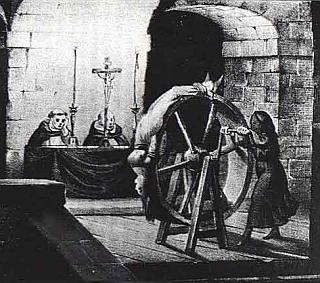Inquisition Bondage
This is clearly supposed to be a scene from Inquisition days — and the lady bound to the wheel is presumably being put to the question on suspicion of being a witch. But I’m not sure I fully understand the purpose of this bondage wheel:

It’s large enough that any tortuous aspect shouldn’t derive from the backward curve of her spine, and it doesn’t appeared to be geared so that she could be spun fast enough to generate extreme misery from motion sickness and nausea, unless that inquisitor really puts his back into the cranking (and clerics of the era were not known for their love of hard work). I’m sure being rotated on that thing would be deeply uncomfortable, but it seems suspiciously mild by the standards for which the Inquisition is notorious. It looks more like something that would be fitting for a play dungeon, not a real one. Anybody know what it was supposed to be for?
Elsewhere on Bondage Blog:


Though not shown, the wheel could be supplemented by putting it in a tank of water or building a fire near one side. There may be spikes along the surface of the wheel. There may be a rope tied around the neck. And though spinning may not be used extensively, how long could you hang upside down in her position? Days may not be uncommon.
i think this is someone’s idea of what it must have been like to be broken on the wheel. boy are they wrong. based on what i’ve read, the wheel was actually a hideous way to leave this world. google it. it’s nasty stuff.
The Wheel ( Bull-wheel ):
The accused witch is stripped naked and secured to the huge wooden wheel with ropes or metal cuffs.
As the huge wheel turns the cuffs around her wrists would draw mercilesssly tight. It was not uncommon for spikes to be along the surface of the wheel.
Some inquisitors would place a bed of hot coals and the base of the wheel. The victim would be slowly roasted alive.
I actually encountered a picture of a similar device today; as two people have already said, a fire was built under the wheel and the victim was rotated down towards it.
Ropeguy,
The spanish inquisition was using a “nondamaging” kind of torture by hours of suffocation. The victim was bound on his/her back with the head down at an angle that is almost upside down. The nose is plugged, a cloth is placed in the mouth, and the victim must swallow a quart of water before getting another breath. A physician stood by to make sure the victim was not physically harmed.
Eight liters a day maximum, for as many days as it took to convince the priests that your recantation of judaism was genuine. If they could not get a recantation, the priests would have them burned at the stake.
It looks to me like the woman on the wheel is perfectly positioned for this type of torture.
It’s not torture – just a way of getting rid of headlice.
I think its simply ment ot get on your nerves and make you go insane…Like chinese water torture.
I read about this picture in a book of punishment once. It claimed that this was drawn in the 1800’s, and is suppose to be an erotic interpretation of the torture. I am not sure how much of this can be taken literal.
The problem is that most medieval torture devices are propaganda tools by opposing regimes. The Iron maiden, for example, is a figment of the imagination of William of Orange, to daemonize Spanish Catholics who were conquering his nation (the reason for the propaganda, of course, was that a large number of his own people liked the Spanish better than they liked him, for good reason).
So he needed lots of spectacular torture devices, do “demonstrate” how evil the Spaniards were.
Now don’t take this the wrong way. I’m not saying torture didn’t exist : medieval Europe tortured it’s prisoners (esp. William of Orange). It’s just that most torture devices are somewhat lacking in visual appeal. Torture mostly consisted of simple things : pulling out nails. Beating a tied-up guy. Near-drowning (not joking around like waterboarding, tying someone up and holding his/her head underwater for 1.5 minutes or longer). Locking someone in a stockade and raping them (in the case of a woman). Causing a wound and letting it fester, then throwing salt into it (try it once with a scratch).
Torture devices from medival europe ? The real torture devices are not so different from today’s tools. Pliers, scissors, short knives, … The most spectacular real torture device I’ve ever seen in European castles’ surviving dungeons was the rope pulley : basically a wooden table with ropes to “stretch out” the victim.
But of course these real devices are not nearly as spectacular as these cool, big and scary contraptions depicted in these propaganda (and sexual fantasy booklets). Don’t forget the large majority of these pictures were made in the 20th century, as works of fantasy. The majority of the rest of them comes from Holland, when “the low lands” (I don’t know the correct English translation of the name) were at war with Spain, long after the Spanish inquisition had ceased to exist.
In reality, the Spanish inquisition, while it did employ torture, was a massive improvement in justice for the average Spaniard. Before the Spanish inquisition if you offended your local “lord”, you basically got killed by soldiers, sometimes your family too. With the inquisition, that changed : to get punished, you had to get convicted by a majority of three votes : one for the king (who had a local representative), one for the church (the local priest), and one for the local nobleman (same as before). For the first time in Spanish history, there was a real law, not just random justice. There was an actual (if remote) possibility that a nobleman would get punished for what he did, and there was a possibility (again, rather remote) that a peasant might stand up successfully to a nobleman.
Another concept that you might know that was pioneered by the Spanish inquisition : a lawyer. The Spanish inquisition was the first legal institution worldwide that allowed the defendant to consult with a legal expert before, and during, trial (and, if you so desired, a priest).
Frankly, William of Orange, along with most of Europe’s nobility, didn’t like this at all : before the inquisition they could just legally kill anyone they wanted dead, which is of course the real reason for this kind of propaganda.
LOL, the one thing I never expected to see on this site (or anywhere, really) was a Spanish Inquisition apologist.
That description, by tomcpp, sounds closer to reality than most the analyses that I have heard.
Had the other descriptions been correct then few of the offenders would have walked to the scaffold/block/pyre as we are told that they did.
[…] a lot of overlap with modern BDSM fantasies and tropes, I’ve never had — despite a few exceptions — a lot of time for that material; my sense of justice, love of due process, and […]
Also in Protestant countries there was a thriving porn industry revolving around stories and pictures of attractive young women being tortured by the evil Catholics. No one could accuse you of being a pornographer if you were educating the public about the evil Papists.